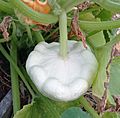Pattypan squash facts for kids
The pattypan squash is a unique and tasty vegetable that looks a bit like a flying saucer! It's also known as a "Sunburst Squash" or a "White Squash" because of its bright colors and interesting shape. This fun vegetable is part of the squash family, which includes many other popular squashes like pumpkins and zucchini. Pattypan squashes can be found in different colors, including white, yellow, and green.
Contents
What Makes Pattypan Squash Special?
Pattypan squashes are easy to spot because of their distinctive shape. They are usually round and flat, with scalloped edges, making them look like a small, edible UFO! They are often harvested when they are quite small, about 2 to 4 inches (5 to 10 cm) wide. At this size, their skin is tender and doesn't need to be peeled before cooking.
Colors of Pattypan Squash
Pattypan squashes come in a few different colors:
- White: These are the most common and often have a mild, slightly sweet flavor.
- Yellow: Bright and sunny, yellow pattypan squashes add a pop of color to any dish.
- Green: Less common, but just as delicious, green pattypans have a slightly richer flavor.
Where Did Pattypan Squash Come From?
Like many other types of squash, the pattypan squash has its roots in the Americas. Squashes have been grown and eaten by people in North and South America for thousands of years. They were an important food source for many ancient civilizations.
A Long History
Evidence shows that squashes were cultivated as far back as 8,000 to 10,000 years ago in parts of Mexico. Over time, different varieties, including the pattypan, were developed and spread around the world. When European explorers arrived in the Americas, they took these interesting vegetables back to their home countries, where they became popular.
How Pattypan Squashes Grow: Life Cycle
Pattypan squashes grow on vines, similar to pumpkins and cucumbers. They are a type of summer squash, which means they grow quickly and are harvested during the warmer months.
From Seed to Squash
The life cycle of a pattypan squash begins with a seed.
- Planting: Seeds are planted in warm soil after the last frost of spring.
- Germination: In about a week, the seeds sprout, and small plants emerge.
- Growth: The plants grow rapidly, developing large leaves and long vines.
- Flowering: Yellow or orange flowers appear on the vines. These flowers are pollinated by bees and other insects.
- Fruiting: After pollination, the flowers develop into small squashes. These squashes quickly grow bigger.
- Harvest: Pattypan squashes are usually ready to pick about 45 to 60 days after planting. They are best harvested when they are young and tender. If left on the vine too long, they can become tough and less flavorful.
Cooking and Eating Pattypan Squash
Pattypan squashes are very versatile in the kitchen. Their mild flavor makes them a great addition to many different meals.
Popular Ways to Cook Them
- Roasting: Cut them in half or quarters, toss with a little olive oil, salt, and pepper, then roast until tender.
- Grilling: Slice them and grill for a smoky flavor.
- Sautéing: Chop them up and sauté with other vegetables for a quick side dish.
- Stuffing: Larger pattypan squashes can be hollowed out and filled with a mixture of grains, vegetables, or meat, then baked.
- Raw: Smaller, very tender pattypans can even be sliced thinly and added to salads for a fresh crunch.
Nutritional Benefits
Pattypan squashes are not just tasty; they're also good for you! They are:
- Low in Calories: A great choice if you're looking for a light and healthy food.
- Rich in Vitamins: They contain vitamins like Vitamin C, which helps your body fight off sickness, and Vitamin A, which is good for your eyes.
- Good Source of Fiber: Fiber helps your digestive system work well and keeps you feeling full.
- Hydrating: Like many vegetables, they have a high water content, helping you stay hydrated.
Images for kids


